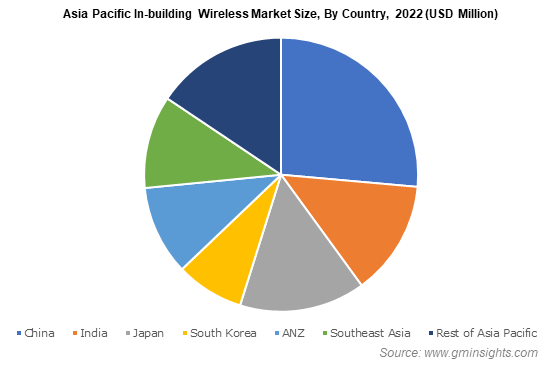Home > Semiconductors & Electronics > Telecom and Networking > Telecom Hardware > In-building Wireless Market
In-building Wireless Market Analysis
- Report ID: GMI4881
- Published Date: Dec 2022
- Report Format: PDF
In-building Wireless Market Analysis
In terms of components, the infrastructure component segment recorded over 75% market share in 2022, driven by the surging penetration of smartphones which is resulting in increased demand for base stations to improve cellular network connections. For instance, small cells are preferred by small cell sites such as small offices and homes to enhance cellular coverage.
In 2022, the small cell infrastructure segment garnered over 27% revenue share of the in-building wireless market. The small cell in-building infrastructure includes low-power range mobile base stations that provide cellular coverage to sparsely populated areas. Small cells can be deployed in a variety of existing infrastructures, including bus stops, information booths, billboards, street manholes, and light poles.
Based on small cell, the picocell segment will witness 11% CAGR through 2032. A picocell increases cellular coverage within buildings. It can be used to extend wireless services to the interiors of buildings and other locations that the network cannot reach. Furthermore, it is well suited to applications requiring huge coverage footprints, such as metropolitan streets and outdoor theme parks. Picocells provide multiple benefits of small cells like improving data throughput for users and increasing capacity in the mobile network.
Based on deployment, the rural in-building wireless market is set to depict around 25.5% CAGR till 2032. The segment's expansion can be attributed to inadequate telecommunications infrastructure rural areas which prevents users from having better cellular service. It is expensive to extend cellular coverage to remote places using traditional LTE methods. Several companies are initiating partnerships to extend their services to rural areas. In December 2021, Ericsson announced a partnership with Nex-Tech Wireless to commercially launch the latter’s 5G capabilities in rural Kansas.

The industrial segment is expected to exhibit a CAGR of 9% CAGR during the forecast timeframe. Modern industrial facilities include cutting-edge sensor technology, machinery, transport vehicles, etc. In-building wireless solutions assist businesses in integrating industrial components and devices.

In the regional context, the Asia Pacific in-building wireless market will expand at 11% CAGR during the forecast period, due to a number of government efforts for the extensive digitalization of urban infrastructure in nations like China, South Korea, and India, the Asia Pacific region is emerging as a highly attractive market for telecom equipment producers and operators.

